Building and sustaining user engagement with your product is a core KPI for a more profitable business. Engaged users are often happy users. Their engagement showcases that your product is providing value and is a sure-fire sign you’re on track to retain loyal customers—who are more likely to help you acquire new ones.
This article is going to give you everything you need to know on user engagement—how to increase it with a stellar strategy, which tools to use, and how your product performance compares to benchmarking metrics. Plus, we bring you the never-before-released best practices from real SaaS companies.
Shall we?
Why is user engagement so important?
Understanding user engagement enables you to build better products, optimize customer communication, and retain users for longer.
Engaged users are more likely to recommend your product to their peers, buy more from your business, and ultimately lift your business’s bottom-line financials.
Also, high engagement rates support product activation rates, a potentially viable product community, and increased free trial-to-paid plan ratios.
How to create an effective user engagement strategy in 6 steps
A user engagement strategy that generates monthly recurring revenue (MRR) comes from following these six steps.
1. Understand your user’s context
First up, you need to understand why your users are using your product or app in the first place. You can do this by answering the following questions:
What job do they need to do?
What problem do they have?
What features have they expressed interest in?
What was their previous solution to fixing their problem?
What’s their role and environment they’re executing their job in?
You can find out the answers by asking your customers directly, be it in their onboarding, during the sales process, or in a 1:1 session with a member from your customer success team.
Mike Yudin, Head of Product at Pushwoosh, explains that you also need to understand where your users come from, what they are looking for, and what their expectations are.
“A lot of product tools and frameworks are aimed at better understanding user context and finding the right words/platforms to deliver value. For an effective user engagement strategy, you need to understand when, at what stages, users interact with your tool, and what you can give them at these moments to push them further down the funnel.”
– Mike Yudin, Head of Product at Pushwoosh
Once you have a solid understanding of your customers, you can begin to see trends within their answers and segment your users into cohorts. These cohorts should then receive personalized and relevant messaging from your business throughout their user journey.
As Mike Yudin puts it:
“Analyze the user journey within your product and choose the right moment to engage with users. Keep asking yourself: How can I help them at this point? For each stage of the funnel, you need to understand:
What to talk about with the user
How to personalize your message
How to maximize your product value for the user
How to take users deeper into the product funnel to eventually turn them into product advocates
If you consider the context and the journey, you will get to develop an unbeatable user engagement strategy that will retain users in your product.”
– Mike Yudin, Head of Product at Pushwoosh
Yudin also emphasizes the importance of adjusting your communication strategy to every persona you have, because "all of the information you put out in the public arena works to shape your image and may help to move your customer further down the funnel".
2. Define positive and negative app engagement
Not all product engagements are great. Some engagements can suggest a user is confused by the navigation of your product, or they’re frustrated with its performance.
Identify what engagements are positive and what engagements should highlight room for improvement.
3. Offer communication opportunities from day one
To get this point across, we’ll take HR onboarding, as an example. When onboarding a new employee to a company, HR put so much emphasis on company culture from day one. Why? It’s their first chance to make an impression and introduce a culture to this person—one they hope to see the new hire echo.
The same happens when onboarding people to products. If you set up a communication culture from day one, users will be open to communication and even encouraged to communicate with your business. In case you need to spread your communication culture internationally, implementing product localization can certainly help.
Note: This is so much harder to do later in the customer lifecycle. We are creatures of habit, so create communication habits as soon as you can.
4. Serve people what they love
Engagement comes down to sentiment and relationships. If your users aren’t fans of your product or brand (check brand awareness metrics for more insights), they’re most probably not going to want to communicate with you. At the same time, if they’re not over the moon with their experience with you, they likely won’t do it, either.
Figured out where we’re going with this?
What you need to focus on is creating ‘promoters’ and quantifying them with an NPS survey. One of the best ways you can win promoters is to give people what they love in a way they love.
If you’re struggling to identify what a positive product engagement is, it’s a good idea to analyze the movements of your promoters. Use screen/session recordings and figure out the actions they’re taking within your product that’s making them fall head over heels with it.
And, this brings us smoothly onto step five...
5. Focus on UX and UI design
User experience and user interface design are two critical areas of focus if you want to create products people love and a platform people want to engage with.
Did you know that 90% of users have stopped using an app because of poor performance? Also, close to 50% of customers will tell their peers about a negative experience.
Your UX/UI design is crucial if you want to build a platform that users engage with, return to, and share. So, you need to create a joyful experience. If your app is a place your users are happy to spend time in, you’ll see engagement rates go up.
This is where in-app tutorials play the main role. Keep in mind that in-product walkthroughs—and even further, in-product marketing strategies—are always best supported with personalized messages, help desk software, product videos (or knowledge base access), and a clear CTA to sign up to the new feature or product you’re offering.
Ensure you collect feedback when trialing anything in-product. Do it right, and it will do wonders. Do it wrong, and it will break trust and push people out of your application.
6. Follow up: Human to human
Last, but certainly not least, engagement is a two-way street. It doesn’t just mean your users are engaging with your brand or product. You need to engage back. To an extent, you can do this via automated processes. For example, using triggered event responses that deliver email messaging or in-app notifications is a great place to start.
For example, Revolut Business does a great job of automating its follow-ups. Take a look at the triggered email example below:
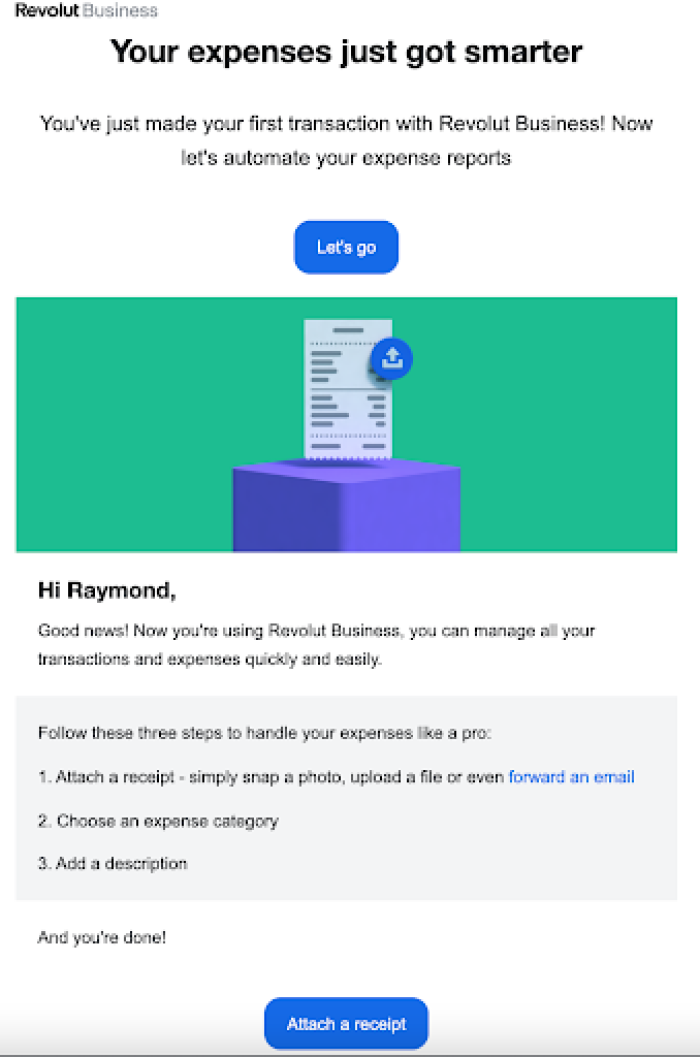
(Source)
However, if your users are taking the time to write to your business, then you need to take the time to communicate back.
User engagement metrics to measure
There are many user engagement metrics you can use to measure and ultimately improve customer engagement.
Here are a few universal user behavior metrics to consider—no matter what your product is.
Active time in-app
First up, how long are your users actively spending in your product or your app? Ideally, you want to measure this over a certain amount of time to determine what’s a healthy time for a user to spend in your app, and what's a healthy amount of clicks that determines they know what they’re doing.
Too many clicks can suggest a user doesn’t know what they’re doing and is clicking unnecessarily or out of frustration.
Too long in your platform with few clicks suggests that the user is inactive. Use screen session recordings to find the perfect balance.
Net Promoter Score
NPS survey results are a fantastic indicator that someone is happy with your tool. In fact, participating in an NPS survey is a sign of positive product engagement in itself—providing the results are equally as positive.
💡 Tip: With Chameleon, you can host your NPS survey directly within your app rather than needing to reach out via email.
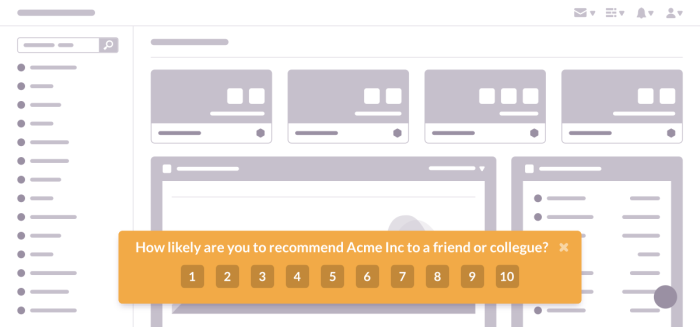
User retention rate
Increasing user retention rates of your tool are also a fantastic indicator for positive user engagement. Engaged users typically stay longer with your brand and product.
“User retention is one of the key metrics to show that your engagement strategy is effective. It also indicates that your product is in demand, and you have achieved product-market fit.”
– Mike Yudin, Head of Product at Pushwoosh
If your user retention rate is on the rise, there’s a high chance your engagement rate is, too, and you might also see an increase in your annual contract value (ACV). One doesn’t happen without the other.
Core feature use
Core feature use or interaction is a KPI that shows that your users understand how your product works and are benefiting from it. If you’re seeing a high amount of clicks around the feature a user signed up for, then you’re onto a winning product sales strategy and onboarding recipe.
A large part of the customer engagement metrics you’ll need to track is specific to your product and its functionality. You could track these manually, or you could use product analytics tools to streamline your process.
Steve Lamar, Founder of PromoPrep, a planning tool for marketers, says there are several metrics his product team uses to measure engagement that are hyper-specific to their tool:
Adding activities: Our number one goal is to get users to add activities to their calendars. The calendar is built for teams, so we track this at a company level. If a company adds a month's worth of activities (or more) within the first 3 web sessions, this is a great signal they will stick around and continue using the platform.
Adding labels: Companies can add labels to their calendar to organize their activities. It is a core function because it allows teams to filter their calendars and set permissions to control what team members can and can't see on the calendar. If a company sets up labels in their first or second session, this is a great signal they will continue to use the platform.
Adding team members: PromoPrep has a free plan for individuals with no limits. This gives 'teams of one' the ability to use the platform, but also gives members of a team enough time to try out the platform to make sure it will work for them. Once a second team member is added, they switch over to a 14-day trial. If a user has been active (adding activities and labels), then adds a team member to start a paid plan trial, this is a great signal they will continue to a paid plan.
– Steve Lamar, Founder of PromoPrep
Here’s an example of how PromoPrep's setting looks like in practice.
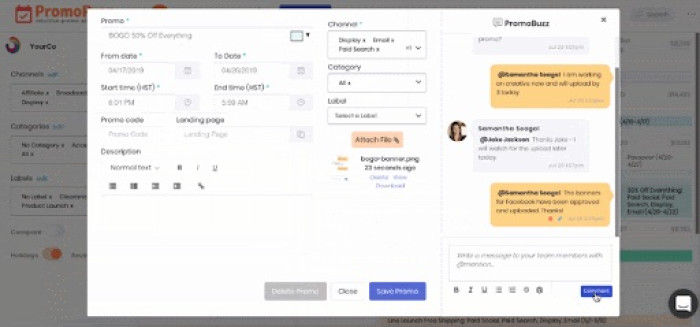
(Source)
Once you’ve identified user engagement metrics that are unique to your product, and lined them up alongside some more common user engagement metrics, you’re ready to start methodizing ways to improve your results.
Product adoption and engagement tools & tactics
Before we get into tools and tactics for customer engagement and product adoption, let’s briefly outline a typical product funnel.
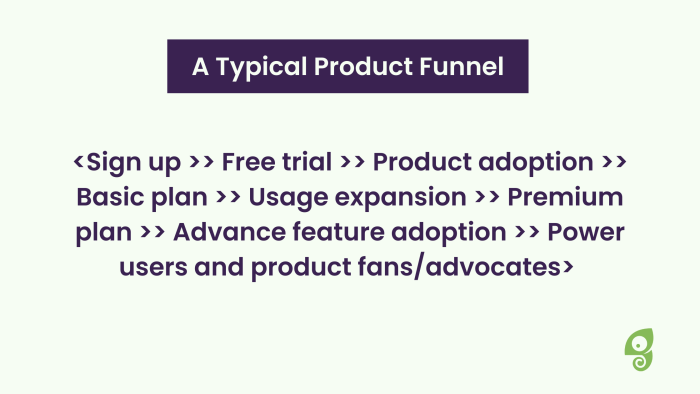
Engagement strategies start from day one, with your product adoption strategies. It all starts with (you guessed it) user onboarding. It’s then repeated with feature onboarding and sustained with onboarding reminders.
Mike Yudin shared his knowledge on the different types of tools and tactics that product teams should be aware of.
“Generally, user engagement tools will fall in one of the two categories—those that involve the user when they are already in the product and those that address the user when they are away from it.
Those outside the product include paid ads, self-serve support, blogs, etc. It is worth noting that these channels target users who have not become advocates of your product yet. So when you use, for example, retargeting with paid ads, you may want to remind the users what your product is about and what its key features are.
Such paid ads will be more effective if you narrow down your segmentation and link it to your product data.
Inside the product, in-product messaging looks the most promising. Relevant prompts, checklists, and onboarding tours work great as they get users to the AHA moment fast, like a real-time assistant.
Keep it in mind, though, that the cues should not interfere with the main user scenario in your product. Help users to reach their goal, not interfere with them.”
– Mike Yudin, Head of Product at Pushwoosh
Whether you’re engaging new users, or you’re trying to (re)engage existing ones, you can use different in-app widgets, messages, and experiences to keep users engaged throughout their entire product lifecycle.
For example, you can use:
Tours: Perfect for a first-time product tour, an interface update, or for a quick guide around a new feature
Tooltips: A great self-serve feature to encourage users to click and engage in all the right places. Tooltips can lend toward your evergreen engagement methods.
Launchers: Deepen user engagement and feature discovery with optional checklists or help menus
Microsurveys: Unsure how you’re doing? Ask your users if they’re with an engagement immediately after they’ve done it with in-app surveys.
3 SaaS examples to generate better user engagement
We spoke with a few B2B and B2C SaaS brands to get their input on how they’re actively optimizing user engagement strategies.
1. PromoPrep: Triggered onboarding
Steve Lamar of PromoPrep added his own input on useful tools for tracking, building, and maintaining user engagement:
“We use Intercom to track user engagement including the number of sessions, team count, activities added and labels added. With this data in Intercom, we are able to set up custom messages to users based on steps they have or have not taken.
For instance, if a user has not set up labels within the first day of signing up, we send them an email with instructions on how to set up labels. We customize our outbound messages based on what the user has already added or not added to their account.”
– Steve Lamar, Founder of PromoPrep
2. Spacer: Optimizing the details
As CEO of Spacer, an online parking marketplace, Michael Rosenbaum takes a very specific approach to user engagement.
"As an online marketplace, user engagement is core to everything we do. In regards to metrics, we primarily focus on on-page and on-site metrics like time on page and pages per session as our base.
We also use tools like Hotjar to dig a little deeper, monitoring metrics like a scroll percentage and noticing trends in where people drop off on key pages. We hold regular user testing sessions to get real-time feedback on how new visitors view the site and what we can do to make their experience more intuitive.
In terms of increasing engagement, there are a few tried and tested tactics that we find help us the most. A/B testing different copy for headers, pop-ups, and banners helps to ensure we understand what information proves most useful to our customers.“
– Michael Rosenbaum, CEO of Spacer
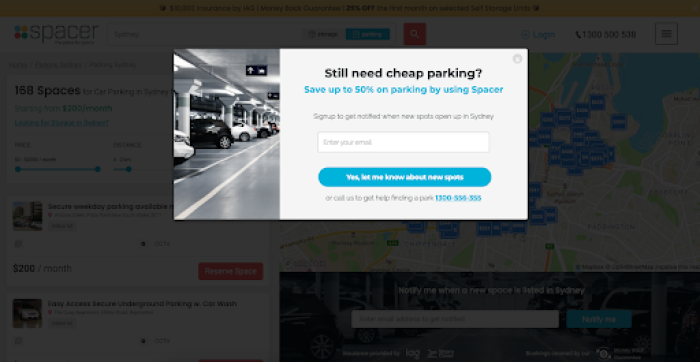
(Source)
Michael Rosenbaum also explains that his team has started adding FAQs section to pages with higher drop-off rates that address any common pain points, which has helped preempt customers' concerns and guide them back to pages with more information if they're not yet ready to book.
3. Better Proposals: Product-centric metrics and methods
Adam Hempenstall, Founder and CEO at Better Proposals, shared his centric viewpoint for creating methods to match specific in-product goals.
“The number one engagement metric we use is the number of users who send their first proposal in the app and get it back signed. Once a customer (free trial or not) reaches this point, they are sure to stay with us for a year at least.”
– Adam Hempenstall, Founder and CEO at Better Proposals
The engagement methods that Better Proposals use for their customers include:
In-app messaging
Proper onboarding procedures
Email reminders
Proposal University, a guide to writing and formatting proposals
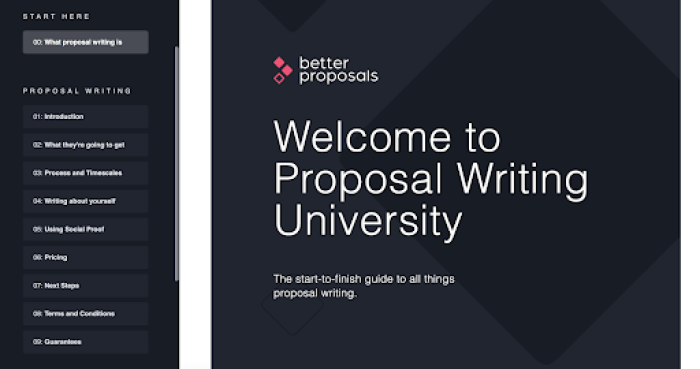
(Source)
“All of this helps. We know we have a great product so it’s all about leading the new customers from point A to point B. Once they reach that point, they’re staying with us.”
– Adam Hempenstall, Founder and CEO at Better Proposals
Ready to engage your users?
Hopefully, this article has shed some light on how to increase user engagement, so you can optimize your own user engagement strategy with confidence.
Remember, when done right, upping user engagement rates will start to up ROI-centric company goals: be it MRR, CLTV, or ACV. When you put your users first and foster a communication culture within your product, you’ll soon benefit from the results.
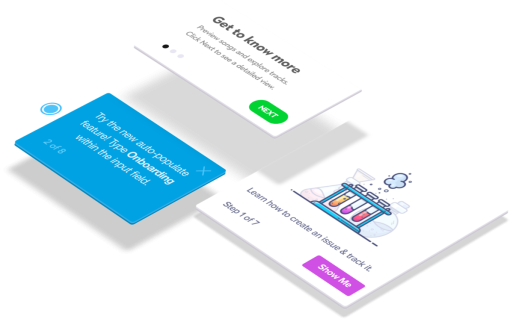
Create in-app experiences that retain and convert users
Chameleon makes it easy for product marketers to create tooltips, modals, and product tours without code





